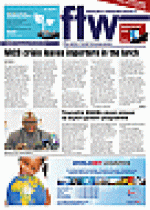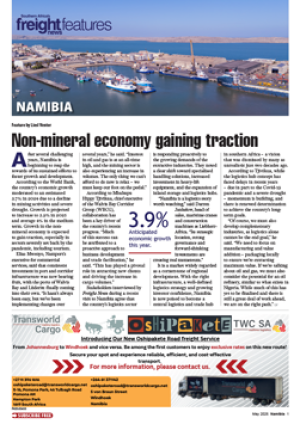Following the recent FTW /
JCCI Customs breakfast held
in Johannesburg, SA Revenue
Service has provided clarity
on several issues raised
by delegates at the event –
provided in Q&A format
below.
Q: Will
determinations
be published?
A: In the old days
you published
determinations. The
wrong determination
can bankrupt a company.
There doesn’t seem to
be an interest in the
new Act to make it
obligatory to publish
determinations.
Sars
The new Act does
make provision for
determinations to be
published. The rules
to the Customs Duty
Act viz. rules 6.4, 7.5
and 8.22 prescribe the
conditions that must be
met for the publication
of information relating
to tariff, value and origin
determinations.
Q: Voluntary
disclosure
A: Historically, voluntary
disclosure results in a
VAT penalty. As soon as
you find something that
is incorrect you must pass
a voucher of correction
according to the Customs
Act, amending and
bringing the duty, VAT
and payment to account.
But then you pay a 10%
penalty. So you do it
voluntarily and you’re still
getting hit.
Sars
The CCA provides for
Voluntary Disclosure
Relief in Chapter 38. The
implementation of this
chapter has, however,
been postponed in
terms of section 943 to
ensure that the required
capacity exists upon
implementation of the
new Acts. It is therefore
behaviour that we would
like to encourage.
The VAT Act, 1991,
and Tax Administration
Act, 2011 provide that
a penalty of 10% be
levied on late payment
of tax. Therefore, there is
currently no discretion not
to levy the penalty.
Q: Who will adjudicate in cases of dispute?
A: You created the tax
ombudsman but it is
limited once section 96 is
declared. So if you go to the
tax ombudsman to complain
about anything, the minute
you do that Section 96 can
be issued and the tax ombud
can no longer comment or
intervene. Will there be an
independent adjudicating
party?
Sars
The definition in the
Customs Control Act,
2014, of “court” includes a
tax court as defined in the
Tax Administration Act,
2011, in relation to a matter
within its jurisdiction . It
is therefore the intention
to extend the Tax Court’s
jurisdiction to certain
customs disputes.
Q: Clearance at
first port of entry
A: On the issue of clearance
at first port of entry, you’re
saying as long as the goods
are precleared they can
proceed inland. But if you
withdraw the status of an
inland port the coast will
be the customs border.
Sars
The current Customs and
Excise Act, 1964, does
not designate any place
inland as an “inland port”
or as a place of entry.
In line with the current
position, provision is
made in the CCA for
container terminals to be
established inland.
Our research indicates
that clearance at the
first port of entry is also
a requirement in other
jurisdictions. For example,
the USA and Canada
require that advance
information be submitted
by the importer. This
information is used
together with the manifest
information submitted
by the carrier for risk
assessment.
In addition the SAFE
Framework advocates
submission of not only an
advance cargo declaration
but also an advance
customs clearance
declaration prior to
loading of the goods
on board a vessel at the
foreign port.
We are currently
working on a conceptual
idea of how to manage
clearance at first port of
entry but we cannot bring
that conceptual idea to
fruition until such time
as we put all the different
supply chain partners in
a room, put up the design
and say let’s unravel what
the problem could be.
Q: Claiming back
provisional
payments
A: What is the time for
claiming back provisional
payments – seven days or
30 days?
Sars
You can claim back
immediately if all the
requirements have
been met. The good
news is that, with the
implementation of
provisional payments, it
will become an automated
process – so for example
in the case of a temporary
importation, on
exportation a secondary
automated process will
trigger the refund of the
provisional payment. In
the next few weeks we are
going out with our change
management campaign.

